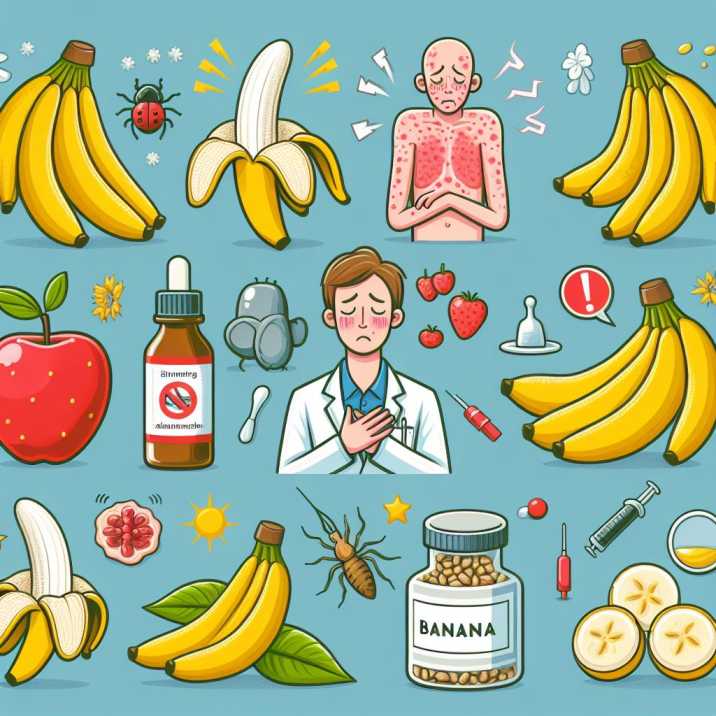Introduction:
Table of Contents
Are there common allergies or reactions associated with consuming Cavendish bananas? This question often arises among individuals curious about potential adverse effects of this popular fruit. In this comprehensive guide, we will delve into various aspects related to allergies and reactions linked to Cavendish bananas, exploring symptoms, causes, management tips, and more.

Understanding Allergies and Reactions
To begin, let’s clarify what allergies and reactions entail when it comes to consuming Cavendish bananas. Allergies refer to the body’s adverse immune response to specific substances, while reactions can encompass various physical responses, including digestive discomfort or skin irritation. It’s essential to distinguish between these two terms to better understand the potential effects of consuming Cavendish bananas.
Common Symptoms
When individuals experience allergies or reactions to Cavendish bananas, they may exhibit a range of symptoms. These can include itching or swelling of the lips, tongue, or throat, hives or rash on the skin, stomach pain, nausea, vomiting, diarrhea, or even difficulty breathing in severe cases. Recognizing these symptoms is crucial for prompt intervention and management.
Causes of Allergic Reactions
Allergic reactions to Cavendish bananas typically occur due to the presence of certain proteins in the fruit. One such protein is chitinase, which shares similarities with proteins found in latex. Individuals with latex allergies may be more prone to experiencing adverse reactions to bananas, including the Cavendish variety. Additionally, cross-reactivity between different fruits, such as kiwi or avocado, can also contribute to allergic responses.
Managing Allergies and Reactions
For individuals with known sensitivities to Cavendish bananas, proactive management is essential. Avoiding direct consumption of bananas and carefully reading food labels to identify hidden sources of banana derivatives in processed foods can help prevent allergic reactions. Moreover, carrying an epinephrine auto-injector for emergency use is recommended for those with severe banana allergies.
Alternative Options
For individuals unable to consume Cavendish bananas due to allergies or reactions, there are plenty of alternative fruits to enjoy. Opting for fruits with similar nutritional profiles, such as apples, pears, or berries, can provide comparable health benefits without triggering adverse reactions. Experimenting with different fruits allows individuals to maintain a balanced diet while accommodating their dietary restrictions.
Seeking Medical Advice
If you suspect you may have allergies or reactions to Cavendish bananas, it’s crucial to consult with a healthcare professional for proper diagnosis and management. Allergy testing, including skin prick tests or blood tests, can help identify specific triggers and guide personalized treatment plans. Your doctor can also provide valuable guidance on managing allergies and incorporating safe dietary practices.
Tips for Prevention
Preventing allergic reactions to Cavendish bananas involves being vigilant about food choices and potential exposure to banana-derived ingredients. Reading food labels meticulously, communicating dietary restrictions to food service providers, and educating friends and family about your allergies can significantly reduce the risk of accidental exposure. Additionally, practicing good hand hygiene and thoroughly washing fruits before consumption can help minimize the risk of cross-contamination.

Importance of Awareness
Raising awareness about allergies and reactions associated with consuming Cavendish bananas is crucial for promoting understanding and empathy within communities. Educating individuals about the prevalence of banana allergies, common symptoms, and appropriate management strategies fosters a supportive environment for those affected by these sensitivities. By fostering inclusivity and empathy, we can create safer spaces for individuals with food allergies to navigate everyday life with confidence.
Conclusion:
In conclusion, while Cavendish bananas are a nutritious and delicious fruit enjoyed by many, it’s essential to acknowledge the potential risks associated with allergies and reactions in certain individuals. By understanding common symptoms, causes, and management strategies, we can empower individuals to make informed decisions about their dietary choices and prioritize their health and well-being. Remember, if you suspect you may have allergies or reactions to Cavendish bananas, don’t hesitate to seek medical advice for personalized care and support.
Frequently Asked Questions (FAQs)
- Can Cavendish bananas cause allergic reactions?
- Yes, Cavendish bananas can cause allergic reactions in some individuals. These reactions are often triggered by proteins present in the fruit, such as chitinase, which shares similarities with proteins found in latex. Individuals with latex allergies may be more susceptible to experiencing adverse reactions to Cavendish bananas.
- What are the common symptoms of banana allergies?
- Common symptoms of banana allergies include itching or swelling of the lips, tongue, or throat, hives or rash on the skin, stomach pain, nausea, vomiting, diarrhea, or difficulty breathing in severe cases. These symptoms can vary in severity and may occur shortly after consuming Cavendish bananas or banana-derived products.
- Are there alternative fruits for individuals allergic to Cavendish bananas?
- Yes, there are several alternative fruits that individuals allergic to Cavendish bananas can enjoy. Fruits such as apples, pears, berries, and citrus fruits offer similar nutritional benefits and can be suitable replacements for Cavendish bananas in the diet. It’s essential to explore and incorporate a variety of fruits to maintain a balanced diet while accommodating dietary restrictions.
- How can I prevent allergic reactions to Cavendish bananas?
- To prevent allergic reactions to Cavendish bananas, individuals should avoid direct consumption of the fruit and carefully read food labels to identify banana-derived ingredients in processed foods. Communicating dietary restrictions to food service providers and practicing good hand hygiene can also help minimize the risk of accidental exposure. Additionally, carrying an epinephrine auto-injector for emergency use is recommended for those with severe banana allergies.
- When should I seek medical advice for banana allergies?
- It is advisable to seek medical advice if you suspect you may have allergies or reactions to Cavendish bananas. A healthcare professional can conduct allergy testing, including skin prick tests or blood tests, to identify specific triggers and guide personalized treatment plans. If you experience severe allergic reactions such as difficulty breathing, swelling of the throat, or loss of consciousness after consuming Cavendish bananas, seek immediate medical attention for prompt intervention and management.
